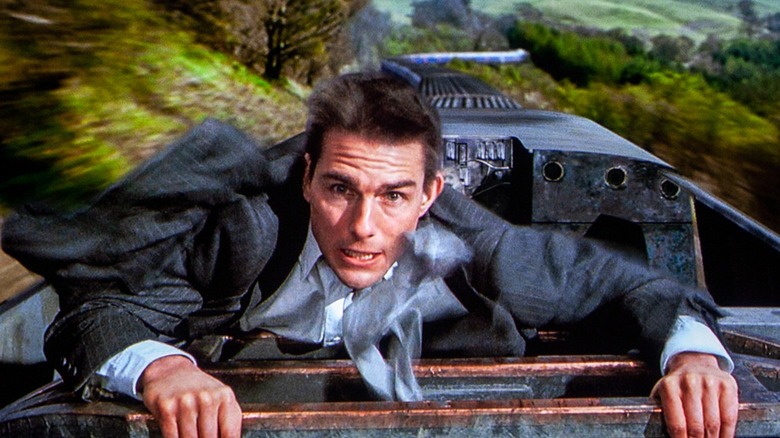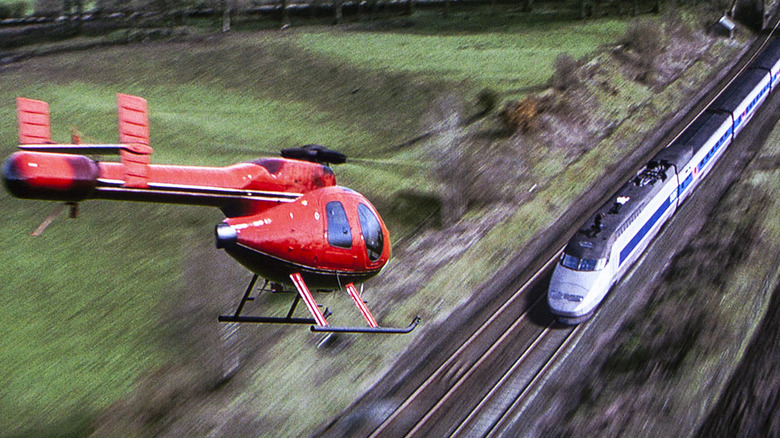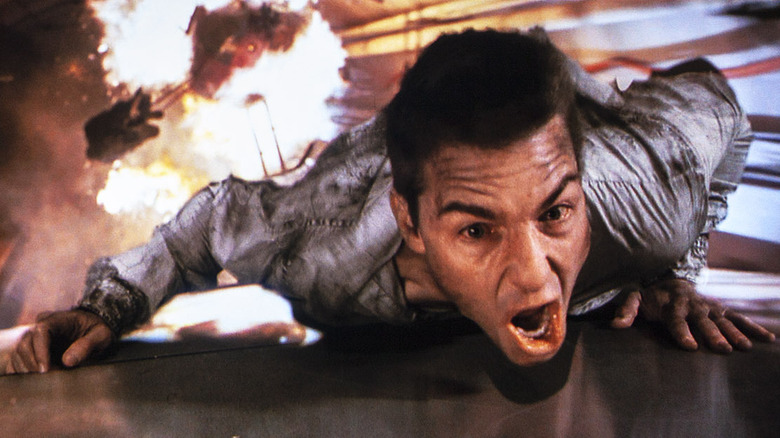
(Welcome to Best Action Scene Ever, a column dedicated to breaking down the best, most effective action sequences throughout the genre. In this edition, we're winding back the clocks to show some love to the Ethan Hunt adventure that started it all: Brian De Palma's "Mission: Impossible" and its climactic bullet train sequence.)
You know what? I get it. After all the incredible feats and widely-marketed stunts that director Christopher McQuarrie and star Tom Cruise have pulled off in the latter "Mission: Impossible" sequels, it's probably easy to become a little jaded and cynical about the franchise as a whole. The overwhelming emphasis on buzzy set pieces and practical, death-defying antics can come at the expense of a memorable story. The formula of the series may sometimes act against it, as there are only so many instances where Hunt's Impossible Mission Force can go rogue and become disavowed by their government before things gets a little stale. And, let's be honest, the seemingly immortal and perpetually unfazed Ethan Hunt doesn't quite boast a sense of charisma or vulnerability that can compete with the likes of, say, Daniel Craig's James Bond.
But it'd be shortsighted to claim that it's always been that way. The impressively long-lasting franchise has undergone quite a bit of change over the years, as a revisit of the original 1996 film makes abundantly clear. And though its humble origins might feel quaint compared to the epic-sized sequels that have followed in its wake, there's no denying the charm and surprisingly effective action of "Mission: Impossible." While we could've easily picked the tense, canted-angle perfection of Hunt's showdown with Henry Czerny's Kittredge or the famous, wire-hanging infiltration to steal that NOC List, the bullet train sequence in the final act set the bar high for everything to come.
The Scene
There's no way around it: If this scene had been filmed within the last decade or two, Tom Cruise undoubtedly would've strapped himself on top of an actual bullet train and shot this sequence for real at 200+ mph. Thankfully, cooler heads (and tighter insurance policies) prevailed back in the mid-1990s and the filmmakers opted for a much less risky, yet delightfully cinematic approach that helps make this set piece stand out to this day.
By this point in the film, the central question surrounding the sinister IMF mole has been all but answered. Once Hunt's suspicions fall squarely on his former mentor and team leader Jim Phelps (Jon Voight), he plays along and arranges an exchange of money for the NOC List on a high-speed bullet train headed to Paris. Phelps soon arrives to reveal himself as the traitor in question, committing coldblooded murder right in front of Hunt before attempting a brazen escape via helicopter from atop the train. Where the movie has largely opted for smaller-scale chess moves involving espionage and double-dealing up to this point, these concluding 15 minutes finally deliver on the spectacle that would go on to define the entire franchise.
Combining the sudden burst of catharsis of the aquarium blowout with the thrilling pacing of the CIA infiltration scene, the bullet train set piece gives its lead character the hero moment that audiences have been waiting for.
Why It Works

The director of "Carrie," "Blow Out," and "Raising Cain" may have seemed like an unconventional option to direct a rather straightforward action/thriller, but it quickly became apparent just how inspired of a choice Brian De Palma really was for a movie like "Mission: Impossible." Featuring plenty of directorial flourishes such as Dutch angles, split diopter shots, and an uncanny knack for sudden twists and reversals, the film expertly weaves De Palma's signature touches throughout the story before reaching its crescendo. This, more than any other scene, explains why the early movies in this franchise naturally lent themselves to having distinctive filmmakers take on each film and put their own unique stamp on them.
In short, De Palma innately understands exactly what this sequence needs at any given moment. Beginning with Phelps admitting his treachery and shooting his own wife without even a hint of remorse, the scene quickly escalates and takes the action outside. Thanks to the use of some downright Alfred Hitchcock-esque rear projection and fans blowing a convincing stream of wind into Jon Voight and Tom Cruise's faces, it's easy to allow the trappings of old-fashioned Hollywood magic to immerse oneself in the visuals on-screen. Once the getaway helicopter is added to the mix and the train bears down on the lengthy Chunnel, all the ingredients are in place for a show-stopping conclusion to one of the most formative blockbusters ever.
Much of it comes down to De Palma's commitment to delivering only the most visceral and adrenaline-pumping moments ... regardless of whether real-world physics would allow for it or not. As soon a helicopter enters a tunnel while chained to a train, all bets are off. But as VFX supervisor John Knoll once noted, it's this disregard for realism that allowed the sequence to truly sing.
The Key Moment

When did "Mission: Impossible" first show signs that it could become the "Mission: Impossible" we've all come to know and love? Oh, I'd say the moment that Ethan Hunt narrowly escapes death at the grisly end of a helicopter's spinning blades and instead leaps onto the flying machine's skids to give the villainous Phelps the sendoff he deserves. In a neat and unexpected callback to his earlier escape from Kittredge in the restaurant, Hunt takes out one last piece of exploding bubble gum, slaps it onto the helicopter windshield, and jumps away from the explosion to land (relatively) safely back on the train in one of the film's most effective money shots.
Of course, this being a Brian De Palma film, that's not quite the end of the action. Hunt still has the fiery remnants of the helicopter to contend with, still chained to the speeding train and on a collision course with the helpless agent. As the train continues to slow down, the wreckage comes to a rest right up against the back of the train ... with the still-spinning (and terrifyingly sharp) propeller blades coming to a rest mere inches from Hunt's throat. Just how well did this scene work? Well, future sequels would go on to consciously evoke this exact moment, most famously in the sequel "Mission: Impossible 2" when the stunt team hung an actual knife only millimeters away from Cruise's eyeball.
By the end of this sequence, Hunt had transformed from a talented IMF agent with luck on his side to one who looked death in the eye and laughed if it meant accomplishing his mission at all costs. Those who misguidedly look down on the "Mission: Impossible" franchise need only watch this movie and this scene to understand its enduring appeal.
Read this next: The 14 Greatest Action Movies Of The 21st Century
The post The Bullet Train Sequence In Mission: Impossible Is The Best Action Scene Ever appeared first on /Film.
0 Comments